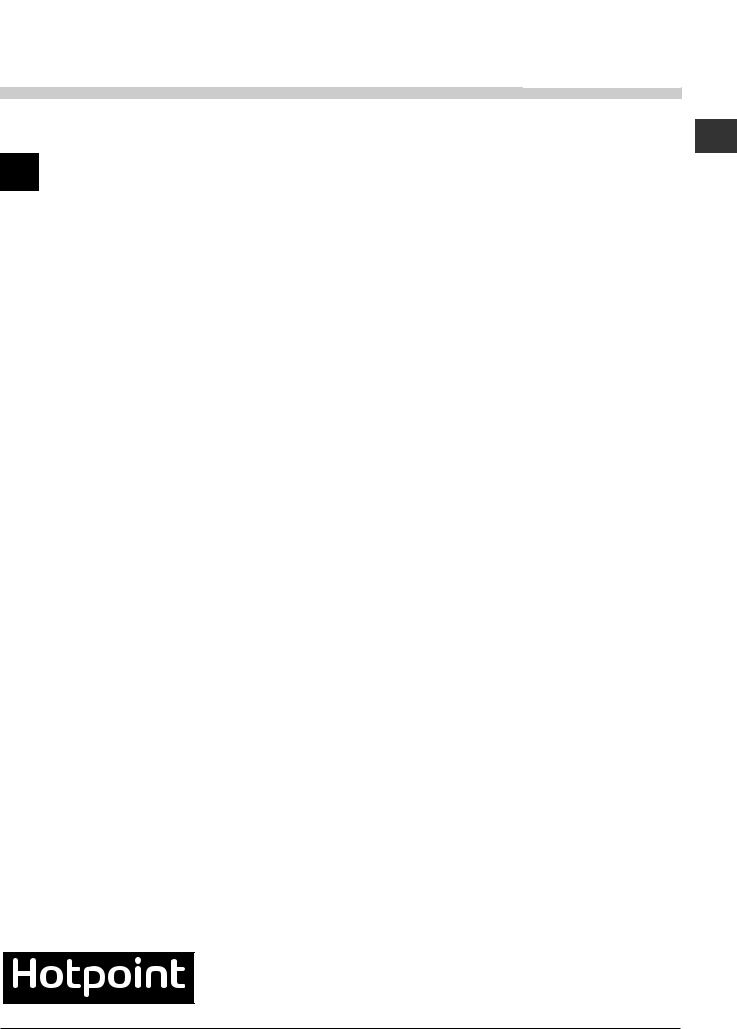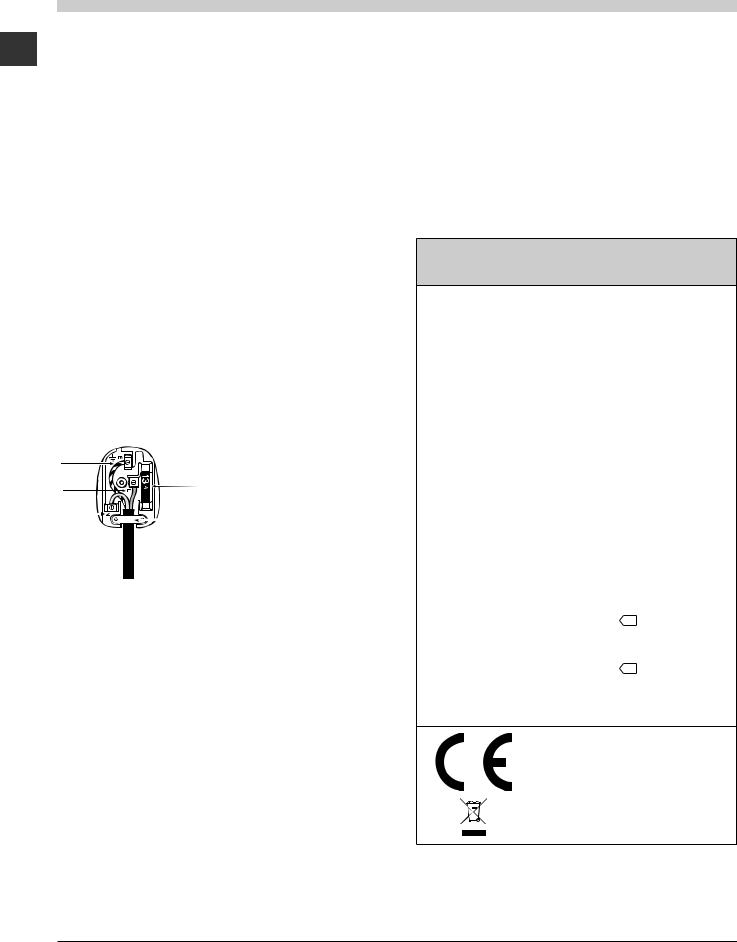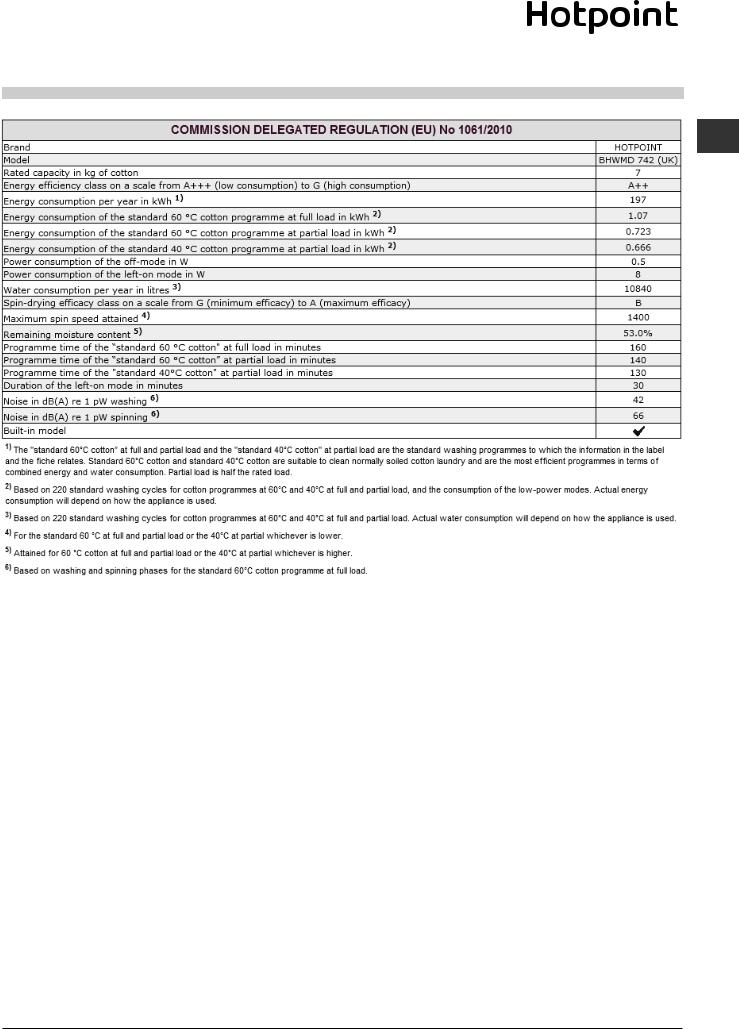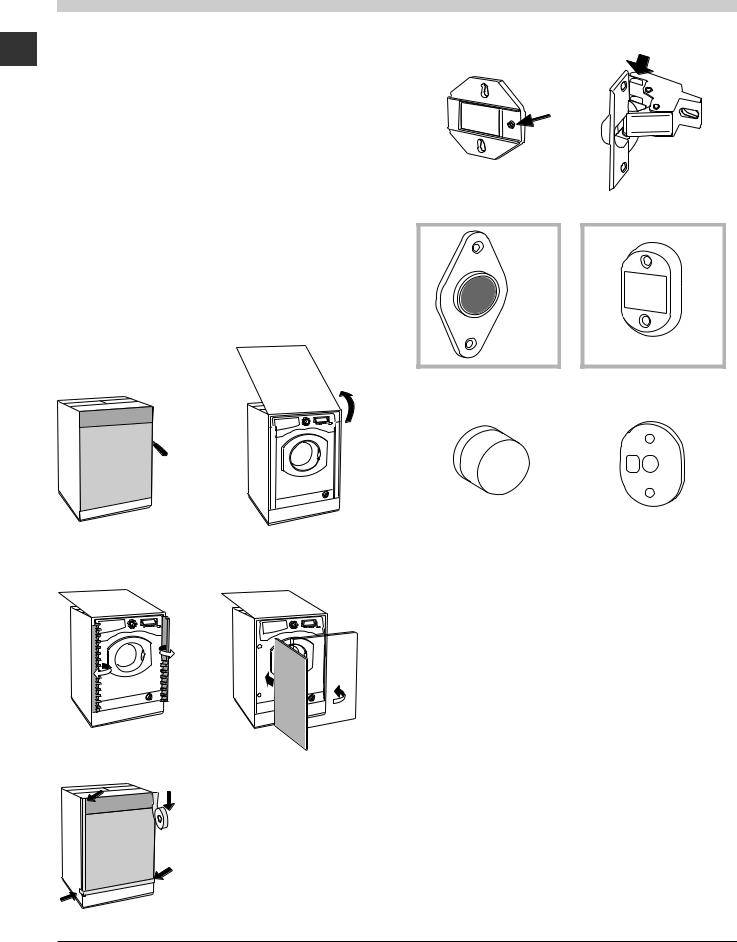HOTPOINT BHWMD 742 (UK) User Manual

Instructions for use
WASHING MACHINE
GB
English,1
Contents |
GB |
|
Installation, 2-3-4-5-6-7
Unpacking and levelling
Connecting the electricity and water supplies
The first wash cycle
Technical data
Instructions for the fitter
Care and maintenance, 8
Cutting off the water or electricity supply Cleaning the washing machine
Cleaning the detergent dispenser drawer Caring for the door and drum of your appliance Cleaning the pump
Checking the water inlet hose
BHWMD 742
Precautions and tips, 9
General safety
Disposal
Opening the porthole door manually
Description of the washing machine, 10-11
Control panel Display
Running a wash cycle, 12
Wash cycles and functions, 13
Table of wash cycles
Wash functions
Detergents and laundry, 14
Detergent dispenser drawer
Preparing the laundry
Special wash cycles
Load balancing system
Troubleshooting, 15-16
Product Guarantee and Repair Information, 17
1

Installation
! Keep this instruction manual in a safe place for GB future reference. Should the appliance be sold, tran-
sferred or moved, make sure the instruction manual accompanies the washing machine to inform the new owner as to its operation and features.
! Read these instructions carefully: they contain vital information on installation, use and safety.
Unpacking and levelling
Unpacking |
!This is a separate part of the polystyrene base and should be removed with the base.
!IMPORTANT check when unpacking your machine.
1.Unpack the washing machine.
2.Check whether the washing machine has been damaged during transport. If this is the case, do not install it and contact your retailer.  3. Remove the 4 pro-
3. Remove the 4 pro-
tective screws and the rubber bush with the respective spacer, situated on the rear of the appliance (see also the installation leaflet).
the angle of inclination, measured according to the worktop, must not exceed 2°.
Levelling your appliance correctly will provide it with stability and avoid any vibrations, noise and shifting during operation. If it is placed on a fitted or loose carpet, adjust the feet in such a way as to allow enough room for ventilation beneath the washing machine.
Electric and water connections
Connecting the water inlet hose
1. Connect the supply pipe by screwing it to a cold water tap using
a 3/4 gas threaded connection (see figu-
re).
Before performing the connection, allow the water to run freely until it is perfectly clear.
2. Connect the other end of the water inlet hose to the washing machine, screwing it onto the appliance’s cold water inlet, situated on the top righthand side on the rear of the appliance (see figure).
|
|
|
|
|
|
3. Make sure there are no kinks or bends in the |
|
|
|
|
|
|
|
||
4. Seal the gaps using the plastic plugs provided. |
|||||||
hose. |
|||||||
5. Keep all the parts: you will need them again |
|
||||||
if the washing machine needs to be moved to |
! The water pressure at the tap must be within |
||||||
another location. |
the values indicated in the Technical details |
||||||
! Packaging materials are not children’s toys. |
table (on the page 5). |
||||||
Levelling |
! If the water inlet hose is not long enough, |
||||||
Your machine may make a considerable amount |
contact a specialist store or an authorised |
||||||
of noise if the two front feet have not been adjusted |
serviceman. |
||||||
correctly. |
|
||||||
1. Install the washing |
! Ensure that the supply taps are allowing wa- |
machine on a flat sturdy |
ter through. Old taps may seize in the closed |
floor, without resting it |
position and thus prevent water reaching the |
up against walls, furni- |
machine. |
ture cabinets or other. |
|
2. If the floor is not per- |
|
fectly level, compensa- |
|
te for any unevenness |
|
by tightening or loo- |
|
sening the adjustable |
|
front feet (see figure); |
|
2 |
|

Connecting the drain hose
65 - 100 cm |
Connect the drain hose, without bending it, to a draining duct or a wall drain situated between 65 and 100 cm from the floor;
Where it connects to the waste water pipe cut end off spigot or remove the blanking cap
The drain hose may be connected to an under-sink trap. Before connecting the drain hose from the machine ensure that any blanks or removable ends have been taken off the spigot.
If it is placed over the edge of a basin or sink be sure the free end of the hose should not be underwater.
! We advise against the use of hose extensions; in case of absolute need, the extension must have the same diameter as the original hose and must not exceed 150 cm in length.
Ensure that if the drain hose is pushed into a standpipe, that the end does not go down more than 15cms (6 inches). If the hose is pushed down too far, this may cause the machine to self -syphon ie. continuously empty as it is filling.
Electric connection
Before plugging the appliance into the mains socket, make sure that:
•the socket is earthed and in compliance with the applicable law;
•the socket is able to sustain the appliance’s maximum power load indicated in the Technical details table (see page 5);
• the supply voltage is included within the |
|
||
GB |
|||
values indicated on the Technical Data Plate |
|||
|
|||
fixed on the machine. |
|
||
|
|||
• the socket is compatible with the washing |
|
||
machine’s plug. If this is not the case, repla- |
|
||
ce the socket or the plug. |
|
||
Your appliance is now supplied with a 13 amp |
|
||
fused plug it can be plugged into a 13 amp |
|
||
socket for immediate use. Before using the ap- |
|
||
pliance please read the instructions below. |
|
||
WARNING - THIS APPLIANCE MUST BE |
|
||
EARTHED. |
|
|
|
THE FOLLOWING OPERATIONS SHOULD BE |
|
||
CARRIED OUT BY A QUALIFIED ELECTRICIAN. |
|
||
Replacing the fuse: |
|
|
|
When replacing a faulty fuse, a 13 amp ASTA |
|
||
approved fuse to BS 1362 should always be |
|
||
used, and the fuse cover re-fitted. If the fuse |
|
||
cover is lost, the plug must not be used until a |
|
||
replacement is obtained. |
|
||
Replacement fuse covers: |
|
||
If a replacement fuse cover is fitted, it must be |
|
||
of the correct colour as indicated by the colou- |
|
||
red marking or the colour that is embossed in |
|
||
words on the base of the plug. Replacements |
|
||
can be obtained directly from your nearest |
|
||
Service Depot. |
|
|
|
Removing the plug: |
|
|
|
If your appliance has a non-rewireable moul- |
|
||
ded plug and you should wish to re-route the |
|
||
mains cable through partitions, units etc., |
|
||
please ensure that either: |
|
||
the plug is replaced by a fused 13 ampere rewi- |
|
||
reable plug bearing the BSI mark of approval. |
|
||
or: |
|
|
|
the mains cable is wired directly into a 13 |
|
||
amp cable outlet, controlled by a switch, (in |
|
||
compliance with BS 5733) which is accessible |
|
||
without moving the appliance. |
|
||
Disposing of the plug: |
|
||
Ensure that before disposing of the plug itself, |
|
||
you make the pins unusable so that it cannot |
|
||
be accidentally inserted into a socket. |
|
||
Instructions for connecting cable to an alternati- |
|
||
ve plug: |
|
|
|
Important: the wires in the mains lead are co- |
|
||
loured in accordance with the following code: |
|
||
Green & Yellow |
Earth |
|
|
Blue |
Neutral |
|
|
Brown |
Live |
|
|
3

As the colours of the wires in the lead may not GB correspond with the coloured markings iden-
tifying the terminals in your plug, proceed as follows:
Connect Green & Yellow wire to terminal marked E or  or coloured Green or Green & Yellow.
or coloured Green or Green & Yellow.
Connect Brown wire to terminal marked L or coloured Red.
Connect Blue wire to terminal marked N or coloured Black.
If a 13 amp plug (BS 1363) is used it must be fitted with a
13 amp fuse, either in the plug or adaptor or at the distribution board.
If you are in any doubt regarding the electrical supply to your machine, consult a qualified electrician before use.
How to connect an alternative plug:
The wires in this mains lead are coloured in accordance with the following code:
BLUE |
|
NEUTRAL (N) |
BROWN |
|
LIVE (L) |
GREEN & YELLOW |
EARTH (E) |
|
|
|
|
GREEN & |
|
|
YELLOW |
|
|
BROWN |
13 ampere fuse |
|
|
|
|
BLUE |
CROSS-BAR |
|
|
CORD GRIP |
|
|
|
|
Disposing of the appliance:
When disposing of the appliance please remove the plug by cutting the mains cable as close as possible to the plug body and dispose of it as described above.
!The washing machine should not be installed in an outdoor environment, not even where the area is sheltered, because it may be very dangerous to leave it exposed to damp, rain and thunderstorms.
!When the washing machine is installed, the mains socket must be within easy reach.
!Do not use extensions or multiple sockets.
!The power supply cable must never be bent or dangerously compressed.
! The power supply cable must only be replaced by an authorised serviceman.
Warning! The company denies all liability if and when these norms are not respected.
The first wash cycle
Once the appliance has been installed, and before you use it for the first time, run a wash cycle with detergent and no laundry, using the
wash cycle  (60°) (1st press of the button).
(60°) (1st press of the button).
Technical data
Model |
BHWMD 742 |
|
|
|
|
|
|
|
width 59.5 cm |
|
|
Dimensions |
height 81.5 cm |
|
|
|
depth 54.5 cm |
|
|
Capacity |
from 1 to 7 kg |
|
|
|
|
||
Electrical |
please refer to the technical |
||
data plate fixed to the ma- |
|||
connections |
|||
chine |
|
||
|
maximum pressure |
||
Water con- |
1 MPa (10 bar) |
|
|
minimum pressure |
|||
nections |
|||
0.05 MPa (0.5 bar) |
|||
|
|||
|
drum capacity 52 litres |
||
Spin speed |
up to 1400 rotations per |
||
minute |
|
||
|
|
||
Test wash |
programme |
(60°) |
|
cycles in |
|||
accordance |
(1st press of the button); |
||
with Re- |
Standard Cotton 60°. |
||
gulations |
programme |
(40°) |
|
1061/2010 |
(2nd press of the button); |
||
and |
Standard Cotton 40°. |
||
1015/2010 |
|
|
|
This appliance conforms to the following EC Directives:
-2004/108/EC (Electromagnetic Compatibility)
-2006/95/EC (Low Voltage)
- 2012/19/EU - WEEE
4

GB
5

Instructions for the fitter
GB
Mounting the wooden panel onto the door and inserting the machine into cabinets:
In the case where the machine must be shipped for final installation after the wooden panel has been mounted, we suggest leaving it in its original packaging. The packaging was designed to make it possible to mount the wooden panel onto the machine without removing it completely (see figures below). The wooden panel that covers the face of the machine must not be less than 18 mm in thickness and can be hinged on either the right or left. For the sake of practicality when using the machine, we recommend that the panel be hinged on the same side as the door for the machine itself - the left.
A B
C D
Tur seite
E
Door Mounting Accessories (Fig. 1-2-3-4-5).
N° 2 Hinge Supports |
|
|
|
|
|
|
|
|
|
|
|
|
|
|
|
|
|
|
|
|
|
|
|
|
|
|
|
|
|
|
|
|
|
|
|
|
|
|
|
|
|
|
|
|
|
|
|
|
|
|
|
|
|
|
|
|
|
|
|
|
|
|
|
|
|
N° 2 Hinges |
|||||
|
|
|
|
|
|
|
|
|
|
|
|
|
|
|
|
|
|
Fig. 1 |
Fig. 2 |
|||||||
N° 1 Magnet |
N° 1 Magnet plate |
Fig. 3 |
Fig. 4 |
|
N° 1 Rubber plug |
|
N° 4 Spacers |
|
|
|
|
|
|
|
|
Fig. 5 |
Fig. 4/B |
||
-No. 6 type A self-threading screws, l =13 mm.
-No. 2 type B metric, countersunk screws,
l =25; for fastening the magnet plate to the cabinet.
-No. 4 type C metric screws, l =15 mm; for mounting the hinge supports to the cabinet.
-No. 4 type D metric screws, l =7 mm; for mounting the hinges on the supports.
Mounting the Parts onto the Face of the Machine.
-Fit the hinge supports to the appliance front panel, positioning the hole marked with an arrow in fig. 1 so that it is on the inner side of the front panel. Fit a spacer (fig. 4/B) between the surfaces using type C screws.
-Fit the magnet plate at the top of the opposite side, using type B screws to fix two spacers (fig. 4/B) between the plate and the surface.
6
